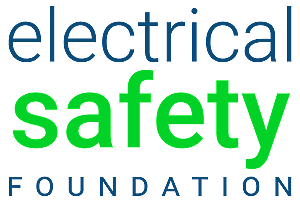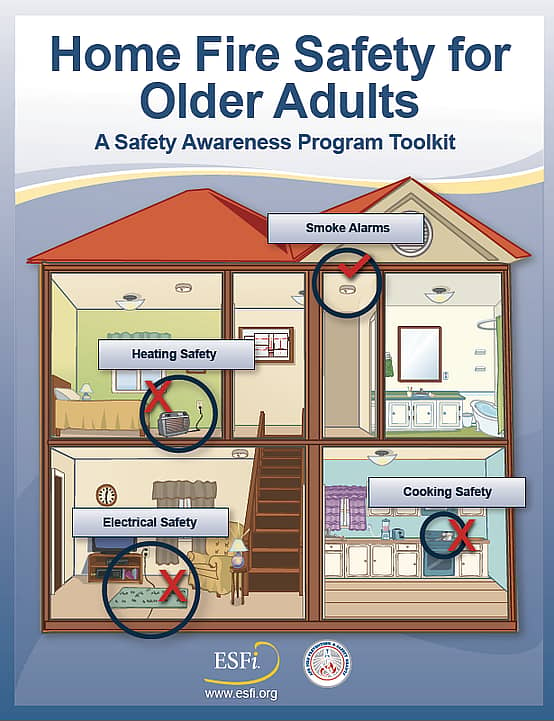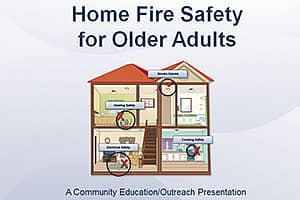- Cooking and Kitchen Safety Tips for Older Adults
- Home Heating Safety Tips for Older Adults
- Home Electrical Safety Tips for Older Adults
- Fire Escape Planning for Older Adults
- Smoke Alarm Safety Tips with Special Considerations for Older Adults
- Emergency Information Sheet
- Smoke Alarm Maintenance Calendar
- Home Fire Safety Checklist for Older Adults
Introduction
Knowledge and awareness are the keys to preventing fires. ESFI urges older adults to take a proactive approach to home fire safety by learning about potential fire hazards and how to prevent them.
This toolkit includes safety tip sheets that provide information about fire hazards related to cooking, heating, and electrical equipment, major causes of home fires every year. Tip sheets for smoke alarms and escape planning are also included. The Home Fire Safety Checklist is a convenient tool for giving your home a fire safety “check-up.” While the Emergency Information Sheet and Smoke Alarm Maintenance Calendar are handy reference tools.
Families and caregivers are encouraged to help older adults review this safety information and/or perform their smoke alarm maintenance activities and home fire safety check-ups. Please share these resources with relatives, friends or other loved ones who can benefit from this critical safety knowledge.
All of the resources included in this toolkit are provided by ESFI at no cost. We encourage you to use them to promote fire safety awareness among older adults in your community. We invite you to copy and distribute the materials, but respectfully request that the content not be revised or altered.
Cooking and Kitchen Safety Tips for Older Adults
Cooking is the leading cause of home fires and home fire injuries year after year. Adults over the age of 65 are at significantly higher risk of dying from a cooking-related fire. These tips will help you cook safely and minimize fire hazards in your kitchen.
Cooking Safety
- Do not cook if you are sleepy, have been drinking alcohol, or have taken medications that make you drowsy.
- Stay in the kitchen when you are frying, grilling, or broiling food. Turn off the stove if you leave the kitchen for even a short period of time.
- If you are simmering, baking, roasting, or boiling food, check it regularly. Use a timer to regularly remind you that you’re cooking.
- Turn handles of pots and pans to the side so you don’t accidentally bump them and spill the contents.
- Wear short, close-fitting, or tightly rolled sleeves when cooking. Loose clothing can easily catch fire if it comes in contact with a gas flame or electric burner.
- Check the kitchen after you finish cooking to make sure the oven burners and other appliances are turned off.
Kitchen Safety
- Keep the stovetop and oven clean. Spilled or baked on food can ignite and start a fire.
- Clean the exhaust hood and duct over the stove regularly.
- Keep towels, dish cloths, and other flammable items away from the stove and other hot surfaces.
- Plug countertop appliances into ground fault circuit interrupter (GFCI)-protected outlets.
- Unplug the toaster and other countertop appliances when not in use.
- Never use an oven or stove for heating your home.
Home Heating Safety Tips for Older Adults
Colder winter weather increases the likelihood of heating realted fires. These fires are the second leading cause of fire deaths among older adults. Keep your home safe and warm all year long with these safety tips.
Heating Safety
- Keep anything that can burn at least three feet away from heating equipment, like the furnace, space heater, fireplace or wood stove.
- Use products only for their intended purposes. Cooking stoves should not be used for heating the home, and space heaters are not for drying wet clothes.
- Have your heating system inspected by a qualified service professional at least once a year.
- Make sure all fuel-burning heating equipment is vented to the outside.
- Keep intake and output vents clean and clear of debris and dust.
- Install and maintain carbon monoxide (CO) alarms to avoid the risk of CO poisoning.
Space Heaters
- Purchase space heaters that have the certification label of a nationally recognized testing laboratory.
- Inspect heaters for cracked or broken plugs or loose connections before each use. If frayed, worn or damaged, do not use the heater.
- Place space heaters on level, flat surfaces, but never place on cabinets, tables or other furniture.
- Keep space heaters out of high traffic areas and doorways where they may pose a tripping hazard.
- Plug portable space heaters directly into an outlet; do not use an extension cord.
- Do not use a space heater in wet or damp areas unless it is specifically designed for use in wet locations such as bathrooms.
- Never leave a space heater unattended. Turn it off when you leave the room or go to sleep.
Fireplaces and Wood Stoves
- Have your chimney or wood stove inspected annually by a certified chimney specialist.
- Always use a sturdy fireplace screen to stop sparks from flying into the room.
- Never leave an open flame unattended, including a fire in the fireplace.
Home Electrical Safety Tips for Older Adults
Electricity has become such a standard part of our daily lives that it is often taken for granted, but electrical failures are a leading cause of home fires every year. Homes with aging electrical systems are at increased risk for electrical fires. Follow these easy safety tips to identify and prevent electrical hazards.
- All electrical work in your home should be performed by a licensed electrician in accordance with local and national codes.
- Have your home electrical system inspected by a qualified professional if:
- Your home is 40 years old or older;
- You purchase a previously-owned home;
- Your home has undergone a major renovation; or
- You have added major new appliances in the last 10 years.
- Consider having your circuit breakers replaced with arc fault circuit interrupters (AFCIs), which provide enhanced electrical fire protection by detecting dangerous arcing conditions.
- Make sure all electrical panel circuits are properly labeled. Always replace fuses or circuit breakers with the correct size and amperage.
- Use ground fault circuit interrupter (GFCI)-protected outlets in areas where electricity is near a water source, like in the kitchen and bathroom.
- Every month, use the TEST buttons to check that GFCIs, AFCIs, and smoke alarms are working properly.
- Routinely check cords, outlets, switches, and appliance for signs of damage. Do not use damaged electrical devices.
- Do not overload outlets with too many devices or appliances.
- Do not use extension cords on a permanent basis, and never use them with major appliances.
- Never run electrical cords under rugs or carpets.
- Do not pinch cords under furniture or in windows/doors.
- Always use light bulbs that match the recommended wattage on the lamp or fixture.
- Look and listen for warning signs of an electrical problem. Contact a licensed electrician if you observe:
- Frequent problems with blowing fuses or tripping circuit breakers;
- A tingling feeling or slight shock when you touch an appliance
- Outlets and/or switches that are warm or make crackling, sizzling or buzzing noises; or
- Flickering or dimming lights.
Fire Escape Planning for Older Adults
Once the smoke alarm sounds, you may only have a few minutes to get to safety. Everyone needs to have a family fire escape plan. Fire escape plans should be updated regularly, however, to address changes that can occur as we age, such as decreased mobility, hearing or eyesight. Use these tips to help ensure your plan is up-to-date.
- Involve all family members in revising/updating your fire escape plan.
- Walk through your home and note any possible exits – including windows.
- Draw a floor plan of your home and mark two ways to escape from each room.
- Consider whether older adults should sleep in a room on the ground floor to make escape easier.
- Make sure that doors and windows leading to the outside can be opened easily by everyone.
- If an older adult uses a walker or wheelchair, check all exits to be sure they can fit through doorways.
- Make any necessary accommodations such as providing exit ramps and widening doorways to facilitate an emergency escape.
- Ensure doorways, hallways, and stairs are clear of furniture and clutter that could become an obstruction or tripping hazard during a fire emergency.
- Utilize battery-powered lights to illuminate paths of exit, or have flashlights readily available and accessible.
- When possible, a responsible family member (and a backup person) should be assigned to assist the elderly or persons with mobility issues who will need assistance to escape.
- Contact your local fire department’s non-emergency line and explain your special needs for fire escape planning, asking them to keep your special needs information on file.
- Check to make sure your house number is easy to see from the street so emergency personnel will be able to find you quickly.
- Practice your fire escape plan at least twice per year.
- Review and revise your fire escape plan as necessary to accommodate new health or mobility concerns.
Smoke Alarm Safety Tips with Special Considerations for Older Adults
Smoke alarms save lives by providing early warning of fire, yet roughly two-thirds of home fire deaths occur in homes without working alarms. Follow these tips to ensure you are protected by working, properly installed smoke alarms.
Age-related hearing loss may make it difficult for older adults to respond quickly to the sound of a standard smoke alarm. Additional smoke alarm safety warning devices should be considered in homes where older adults reside.
- Smoke alarms should be installed in every bedroom, outside each sleeping area, and on every level of the home.
- For the best protection, smoke alarms should be interconnected so that they all sound if one sounds.
- Choose alarms that bear the label of a nationally-recognized testing laboratory.
- If possible, alarms should be mounted in the center of the ceiling.
- Test smoke alarms on a monthly basis by pressing the TEST button.
- Batteries for battery-operated or battery back-up alarms should be replaced at least once a year. If an alarm “chirps” or “beep,” replace batteries immediately.
- Occasionally dust or lightly vacuum the exterior of the alarms to remove dust and cobwebs.
- All smoke alarms should be replaced at least every ten years or sooner if indicated in the manufacturer’s instructions.
Smoke Alarm Considerations for Older Adults
- Test smoke alarms to make sure everyone in your home can hear them, even when they are asleep. Some older adults may not be awakened by the sound of the smoke alarm.
- Notification appliances that are separate from the smoke alarm and produce complex low frequency audible signals upon activation can be used to awaken those with mild to severe hearing loss.
- If anyone in your household is deaf, or if your own hearing is diminished, consider installing a smoke alarm that uses a flashing light or vibration to alert you to a fire emergency.
- High intensity strobes are used as a method of waking those who are deaf or who have profound hearing loss. Smoke alarms are available with strobe feature or the ability to be used with strobes. Pillow or bed shakers that are activated by the sound of the alarm are required to be used with strobes.
- Smoke alarms with built in or separate strobes can be purchased through home improvement store websites or by searching the Internet for “strobe light smoke alarms.”
- If possible, both a family member and a backup person should be assigned to help awaken those with hearing loss during fire drills and emergencies.
- Smoke alarms require regular testing and maintenance to ensure they are working properly. Families and/or caregivers may need to assist older adults with these tasks.
Emergency Information Sheet
Post this emergency information sheet on your refrigerator or in another easily visible location near your telephone. Even the most basic information can be hard to recall during an emergency. Write down your name, home address and phone number so that you can easily provide this information to 9-1-1.
Information Sheet may be downloaded from the Home Fire Safety Toolkit.
Smoke Alarm Maintenance Calendar
Smoke alarms save lives, but only if they are working properly.
Use this calendar to record the dates that you perform your annual smoke alarm maintenance activities. If you are unable to complete these tasks yourself, give this calendar to a family member or friend and ask them to assist you.
Remember that smoke alarms should be completely replaced at least every ten years. Use the for on the back of the calendar to keep track of the manufacture dates for your alarms.
Maintenance Calendar may be downloaded from the Home Fire Safety Toolkit.
Home Fire Safety Checklist for Older Adults
Use this checklist to help find and correct fire safety hazards in your home before they can start a fire or injure someone.
The checklist includes steps for reviewing:
- Smoke Alarms
- Fire Escape Plans
- Kitchens
- Electrical Switches and Outlets
- Electrical Cords
- Electrical Panel
- Heating Equipment
- If you are unable to complete of the items on this checklist by yourself, ask a family member or someone close to you for assistance.
Home Fire Safety Checklist may be downloaded from the Home Fire Safety Toolkit.






